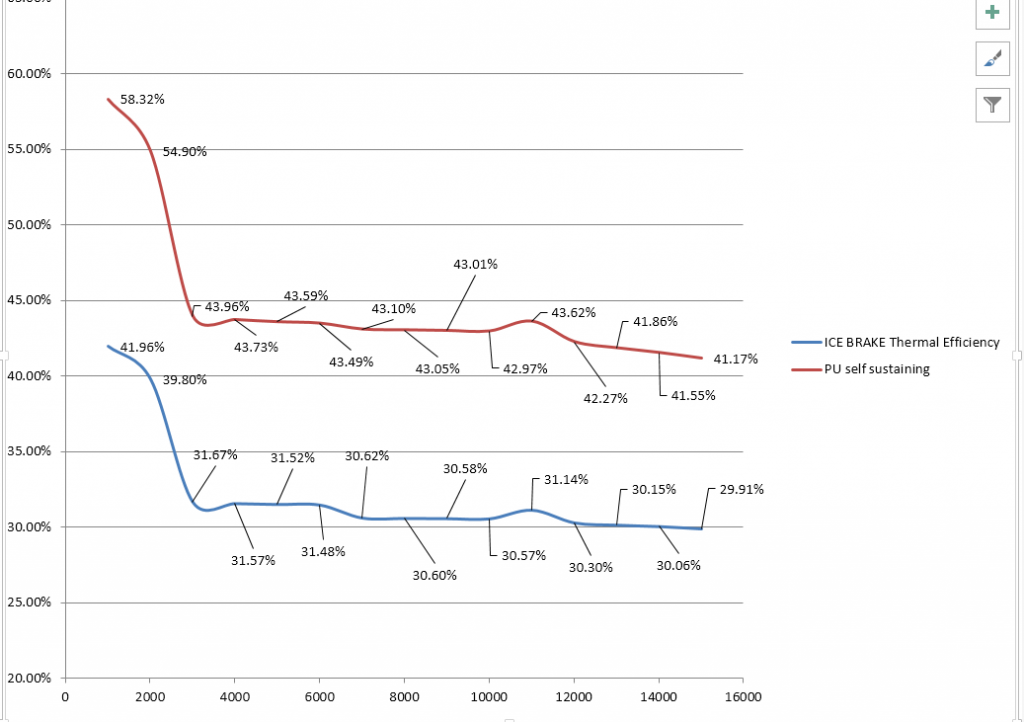Tommy Cookers wrote:Tommy Cookers wrote:
http://naca.central.cranfield.ac.uk/rep ... rt-822.pdf
the combined power is always best around best bsfc
best bsfc is with -20" Hg on the engine used (probably -15" Hg on an engine with more liberal valve timing)
ie the loss at the crank is the same or less than the gain via the MGUH as the delta P becomes more negative
so 120 kW recovered power might cost 100 kW crankshaft power without any fuel rate limit
but the bsfc as reported is 14% better at 10000' than the same engine with turbo
extrapolation suggests 10% better at sea level
so under a fuel rate limit there's 10% more combined power with this level of compounding
but the F1 engine 'boost' will be much higher, so the best bsfc delta P might be more, maybe close to -1 bar ?
so the bsfc gain over an equivalent turbo engine should be maybe 15%
(because recovered power is largely due to the pressure difference between exhaust pressure and ambient)
giving 15% more combined power with this 'best bsfc' level of recovery
of course a suitably big MGUH and related electrical system is needed
a lower level of recovery such as Wright actually used would according to this report give only maybe 7% bsfc gain
(at lower recovery levels the bsfc gain comes from recovery that costs very little crankshaft power)
and so only 7% more combined power under a fuel rate limit
but would use a much smaller capacity MGUH and related electrical system
with a turbine-electric recovery system as in new F1 .......
in a low recovery level system the electrical power can reasonably described as free
as the efficiency improves in proportion to the electrical power
at maximal recovery level as in NACA 822 only about half the electrical power can be regarded as free
because the efficiency gain is 'only' about half the recovery level
so we should resist the inevitable media and PR attempts to tell us that eg a 120 kW MGUH recovers that much 'free'
NACA 822 is based on running at pressure (loosely, 'boost') of 40" Hg Abs (about 1.35 bar Abs)
the supercharger power is rather low, around 3 % of output power
just bumped these 2 posts for the link - might be useful for those who haven't read the whole thread (from around p 355)
maybe gg will take NACAs word that running at true backpressure is good if the exhaust valve closure is suitable ?
raised exhaust pressure helps reduces blowdown losses (my story - and it features in eg Caterpillar's compound piston patent)
and improves efficiency of the turbine expansion phase (gg's story iirc)
I know I responded to your original post some time ago. I accept the findings published in NACA 822 without question but there are at least two issues that make me wary of extrapolating the numbers to a current F1 engine.
1. There is a huge difference in specific output between the NACA test engine and a current F1 engine.
Approx 15 bar vs 38 bar BMEP. i.e. about
2.5 times the BMEP.
Specific power is approx 25 kW/L for the test engine and 350 kW/L for the F1 i.e. about
14 times the specific output.
My point here is the thermal loading. At such high levels of specific power, the F1 engine requires scavenging during valve overlap to remove heat from combustion chamber components. Wave action will help a little but high levels of scavenge cooling will require a positive pressure differential (MAP/EBP).
2. The NACA engine is carburetted. Any scavenge will waste fuel and negatively impact the SFC. The paper records best SFC
"varies only slightly from the minimum for a range of exhaust pressures from 5% to 45% above MAP". Clearly with such a wide range, the SFC is not particularly sensitive to EBP but at less than 5% (approaching positive DP) the engine is beginning to scavenge fuel out the exhaust and SFC suffers. Of course the current F1 engines are DI and scavenging without loss of fuel is possible.
Also significant is the very high BMEP of the F1 engine and the significance of pumping losses. Increasing BP by 1Bar will reduce the BMEP by approximately 1 bar (PMEP will increase by about 1Bar). The same applies when increasing MAP - BMEP increases and PMEP reduces by about 1Bar. Consequently increasing both boost and back pressure by 1Bar will have negligible effect on pumping work.
As to compressor and turbine work, I have done some rough calculations for two scenarios.
1. MAP = 3.5, EBP = 3.0 Power(compressor) = 80 kW. Pt = 125 kW. Psurplus = 45 kW
2. MAP = 4.5, EBP = 4.0 Pc = 130 kW. Pt = 177 kW. Ps = 47 kW
The upshot is clearly line ball. Not much change in pumping losses, BMEP of the recip' machine nor surplus power from the turbo machinery. OTOH reducing the DP (by increasing EBP) to the following scenario might be useful.
3. MAP = 3.5, EBP = 3.5 Pc = 80 kW. Pt = 140 kW. Psurplus = 60 kW That's a 15 kW improvement. The PMEP will increase by 0.5 Bar so BMEP reduces to 37.5 and crankshaft work suffers by about 7.5 kW
All the above calculations are based on steady state flow, any harvesting of blowdown energy will obviously improve the numbers.




